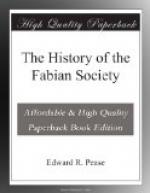[17] On this passage Shaw comments, beginning with an expletive, and proceeding: “I was the only one who had any principles. But surely the secret of it is that we didn’t really want to be demagogues, having other fish to fry, as our subsequent careers proved. Our decision not to stand for Parliament in 1892 was the turning point. I was offered some seats to contest—possibly Labour ones—but I always replied that they ought to put up a bona fide working man. We lacked ambition.”
[18] See “The Great Society,” by Graham Wallas (Macmillan, 1914), p. 260.
[19] For a much fuller account of this subject, see Appendix I. A.
[20] See Appendix II.
[21] See Fabian Tract 147, “Capital and Compensation,” by Edw. R. Pease.
[22] See “Fabian Essays,” p. 51, for the first point, and Fabian Tract No. 119 for the second.
[23] See “The Story of the Dockers’ Strike,” by Vaughan Nash and H. (now Sir Hubert) Llewellyn Smith; Fisher Unwin, 1890.
Chapter V
“Fabian Essays” and the Lancashire Campaign: 1890-3
“Fabian Essays” published—Astonishing
success—A new presentation of
Socialism—Reviewed after
twenty-five years—Henry Hutchinson—The
Lancashire Campaign—Mrs.
Besant withdraws—“Fabian News.”
Volumes of essays by various writers seldom have any durable place in the history of thought because as a rule they do not present a connected body of ideas, but merely the opinions of a number of people who start from incompatible premises and arrive at inconsistent conclusions. A book, to be effective, must maintain a thesis, or at any rate must be a closely integrated series of propositions, and, as a rule, thinkers strong enough to move the world are too independent to pull together in a team.
“Fabian Essays,” the work of seven writers, all of them far above the average in ability, some of them possessing individuality now recognised as exceptional, is a book and not a collection of essays. This resulted from two causes. The writers had for years known each other intimately and shared each other’s thoughts; they had hammered out together the policy which they announced; and they had moulded each other’s opinions before they began to write. Secondly the book was planned in advance. Its scheme was arranged as a whole, and then the parts were allotted to each author, with an agreement as to the ground to be covered and the method to be adopted,




